Is Rt 12 in Utica Flooded Again
Home » Oil and Gas » Utica Shale
Utica Shale - The Natural Gas Giant Beneath the Marcellus
Stacked plays in the Appalachian Basin produce multiple natural gas pay zones.
Article past: , PhD, RPG
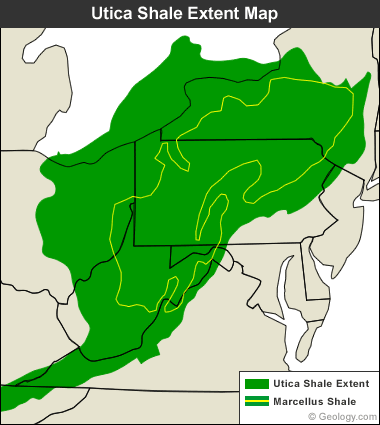
Figure one: The green area on this map marks the geographic extent of the Utica Shale. Included in this extent are two laterally equivalent rock units: the Antes Shale of fundamental Pennsylvania and Point Pleasant Formation of Ohio and western Pennsylvania. These rocks extend below several U.S. states, part of Lake Erie, part of Lake Ontario and part of Ontario, Canada. If developed throughout this extent, the Utica Shale gas play will be larger than any natural gas field known today.
The thin yellow line on the map outlines the geographic extent of the Marcellus Shale Gas Play. This map clearly demonstrates that the Utica Shale has a geographic extent that is much greater than the Marcellus Shale.
This map was compiled by Geology.com using data provided by the Energy Data Administration [1] and the The states Geological Survey [2].
What is the Utica Shale?
The Utica Shale is a black, calcareous, organic-rich shale of Eye Ordovician age that underlies significant portions of Ohio, Pennsylvania, West Virginia, New York, Quebec and other parts of eastern Northward America (run into Effigy ane). In the subsurface, the Utica Shale is located a few one thousand anxiety below the Marcellus Shale, which has become widely known as a source of natural gas (run into Effigy two).
The Utica Shale is currently receiving a lot of attention because information technology is yielding large amounts of natural gas, natural gas liquids and rough oil to wells drilled in eastern Ohio and western Pennsylvania. The U.s.a. Geological Survey's mean estimates of undiscovered, technically recoverable unconventional resources point that the Utica Shale contains near 38 trillion cubic feet of natural gas, about 940 million barrels of oil, and 208 million barrels of natural gas liquids [15].
Geologists take long considered the Utica Shale to be an oil and natural gas source stone. Natural gas and oil generated in the Utica Shale take migrated upwards and are produced from reservoirs in overlying rock units. An even greater quantity of oil and natural gas is withal trapped in the Utica Shale.
The Utica Shale has not been extensively developed for two reasons: 1) its corking depth over much of its geographic extent, and, 2) its limited ability to yield gas and oil to a well because of its low permeability. This is starting to change as horizontal drilling and hydraulic fracturing are used to stimulate product. These methods were non extensively used in the Utica Shale prior to 2010.

Effigy 1a: This map shows an example of the extremely high drilling density of horizontal wells in the eastern Ohio portion of the Utica Shale. At that place must be a "sweetness spot" down there!
Related: Learn About Mineral Rights
The Marcellus was the Opening Deed
The Marcellus Shale is another organic-rich rock unit of measurement that historically attracted limited commercial interest because of its low permeability. However, that changed in 2003 when Range Resources began drilling productive wells into the Marcellus using horizontal drilling and hydraulic fracturing technologies. These methods solved the low permeability problem and produced fractures that allowed fluids to menstruation through the rock unit and into a well.
Now, just a few years later, the Marcellus Shale has go 1 of the globe'southward largest natural gas fields, and the Utica Shale - located a few thousand anxiety below the Marcellus - has become a new drilling target.
The oil and natural gas potential of the Utica Shale is non fully understood. It has just been seriously drilled in eastern Ohio since 2010 (come across Figure 1a). Withal, it is already becoming a significant oil, natural gas and natural gas liquids producer. It is more than geographically extensive than the Marcellus (meet Effigy i), it is thicker than the Marcellus (run across Effigy six), and it has already proven its ability to yield commercial quantities of natural gas, natural gas liquids and crude oil.
It is impossible to say at this time exactly how large the Utica Shale resource might be because it has only been lightly drilled in western Pennsylvania and in the St. Lawrence Lowlands of Quebec, Canada. In central Pennsylvania, where the Utica is deep beneath the Marcellus, information technology is virtually untested with horizontal drilling and hydraulic fracturing. Limited testing suggests that the Utica Shale will be an enormous fossil fuel resources.

Figure 2: Generalized stratigraphic sequence of rock units surrounding the Utica Shale and Marcellus Shale. The Utica and Marcellus are then geographically all-encompassing that information technology is impossible to present a stratigraphic sequence that would exist right in all areas. This diagram presents a generalized sequence of rocks that might exist present in central and western Pennsylvania. Epitome by Geology.com.
How Deep is the Utica Shale?
The Utica Shale is much deeper than the Marcellus. The Utica Shale elevation map (shown as Figure 3 in the right column of this page) has contour lines that bear witness the elevation of the base of operations of the Utica Shale in feet below sea level. In some parts of Pennsylvania, the Utica Shale can be over two miles below sea level. Still, the depth of the Utica Shale decreases to the west into Ohio and to the northwest under the Corking Lakes and into Canada. In these areas the Utica Shale rises to less than 2000 anxiety below body of water level. Beyond the potential source stone areas, the Utica Shale rises to World's surface and tin can be seen in outcrop. An outcrop photo of the Utica Shale near the town of Donnacona, Quebec, Canada is shown as Figure 4.
Near of the major rock units in the Appalachian Bowl are thickest in the due east and sparse towards the west. The rock units that occur betwixt the Marcellus Shale and the Utica Shale follow this trend. In central Pennsylvania, the Utica tin can exist upwards to 7000 feet below the Marcellus Shale, but that depth deviation decreases to the west. In eastern Ohio the Utica can exist less than 3000 feet below the Marcellus.
These depth relationships of the Utica Shale and the Marcellus Shale are shown in the generalized cantankerous sections shown below as Figure 5a and Figure 5b.
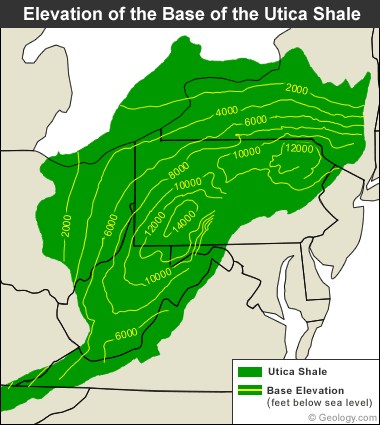
Figure 3: Approximate peak for the base of the Utica Shale (peak of the Trenton/Black River Limestones). Elevations shown on the map are feet below ocean level.
This map was compiled by Geology.com using data provided by the Energy Information Assistants [one], the U.s.a. Geological Survey [2], and the Pennsylvania Geological Survey [three].
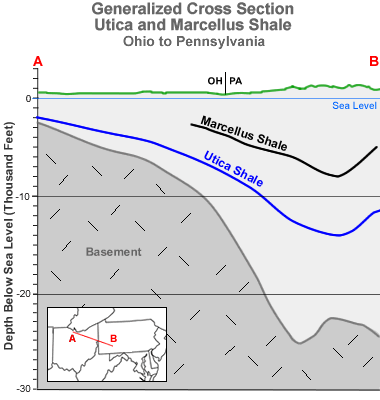
Effigy 5a: The cantankerous section above shows the subsurface position of the Marcellus Shale, Utica Shale and the continental basement stone. The line of cross section is shown as line A-B on the inset map. Notation that the Utica Shale is about 2000 anxiety below the Marcellus under eastern Ohio but virtually 6000 feet below the Marcellus in due south-central Pennsylvania. Also notation that the Marcellus Shale potential source rock does not extend every bit far into Ohio as the Utica.
This cross section was compiled past Geology.com using data provided by the Energy Data Administration [1], the U.s. Geological Survey [2], the Pennsylvania Geological Survey [iii], and the U.S. Department of Energy [iv].
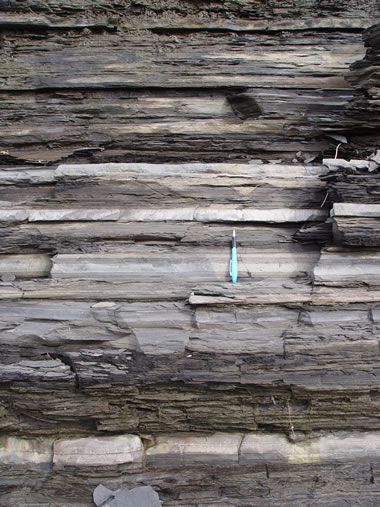
Figure 4: Photograph of the Utica Shale near the town of Donnacona, Quebec, Canada. Nighttime beds are shale, calorie-free beds are limestone. Part of the dark colour in the Utica Shale comes from organic matter. A writing pen is shown for calibration. Image and caption by The National Energy Board of Canada; from A Primer for Understanding Canadian Shale Gas. [ten]
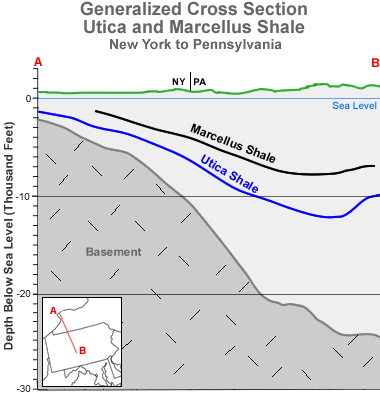
Figure 5b: The cross section above shows the subsurface position of the Marcellus Shale, Utica Shale and the continental basement rock. The line of cantankerous section is shown equally line A-B on the inset map. Notation that the Utica Shale is about 1800 feet below the Marcellus under western New York only almost 5000 feet below the Marcellus in south-central Pennsylvania. Also note that the Marcellus Shale potential source rock does not extend every bit far into New York every bit the Utica.
This cross section was compiled by Geology.com using data provided past the Energy Information Assistants [1], the United States Geological Survey [2], the Pennsylvania Geological Survey [3], and the U.Due south. Department of Energy [4].
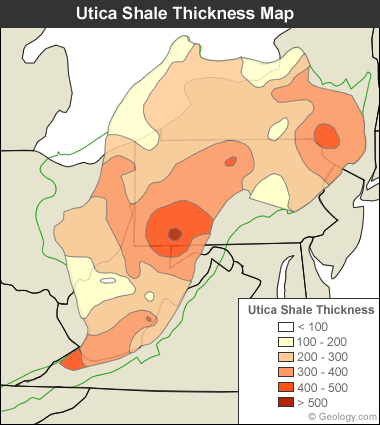
Effigy vi: Thickness map of rocks present between the top of the Trenton/Black River Groups and the top of the Utica Shale. In some areas the Point Pleasant Shale and the Antes Shale are included in this thickness.
This map was compiled past Geology.com using data provided by the Energy Information Assistants [1] and the U.S. Section of Energy [iv].
Thickness of the Utica Shale
The thickness of the Utica Shale is variable. Throughout most of its extent, it ranges in thickness from less than 100 feet to over 500 feet. Thickest areas are on the eastern side of its extent, and it generally thins to the northwest. A thickness map of the Utica Shale is shown as Figure six. Although thickness of a rock unit is important in determining its oil and gas potential, the organic content, thermal maturity and other characteristics must all be favorable.
Organic Content of the Utica Shale
The Utica Shale is an organic-rich stone unit. The organics are what give it a nighttime gray to blackness color - and hydrocarbon potential. The amount of organic material in the shale varies throughout its extent and also varies vertically within the stone unit of measurement.
A map of the regional variation in total organic carbon is shown every bit Figure seven. The organic carbon content is generally highest in the center of the stone unit'south extent and decreases towards its margins.
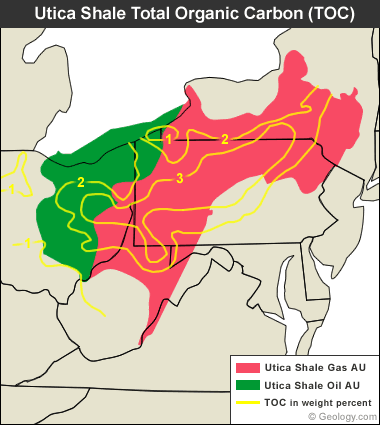
Figure 7: Total Organic Carbon content of the Utica Shale and equivalent rocks (weight percent). This map shows that the full organic carbon content is highest (greater than 3%) in the judge eye of the geographic extent. High full organic carbon values are often correlated with a high potential of oil and natural gas generation.
This map was compiled by Geology.com using information from the United States Geological Survey [15].
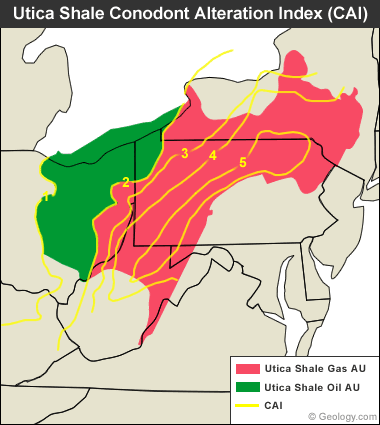
Figure 10: Conodont Alteration Alphabetize Map of the Utica Shale and equivalent rocks. CAI correlates with the thermal maturity of the rocks. CAI values between 1 and 2 are normally associated with the presence of rough oil, while CAI betwixt 2 and v are normally associated with the presence of natural gas.
This map was compiled by Geology.com using data from the United States Geological Survey [15].
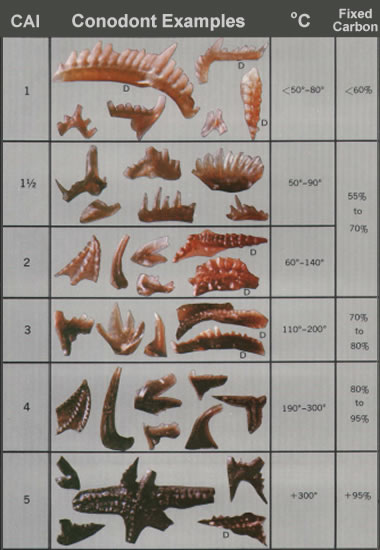
Figure 8: Examples of colour amending in conodont fossils. Image by USGS. [17]
| CAI | Approximate conodont color | Temperature (Celsius) |
| one | Pale brownish | <fifty°-fourscore° |
| 2 | Dark brownish | lx°-140° |
| 3 | Dark grey-brown | 110°-200° |
| 4 | Night grey | 190°-300° |
| 5 | Black | 300°-480° |
| 6 | Pale grey | 360°-550° |
| Figure 9: Conodont Amending Alphabetize chart (CAI). | ||
Conodont Alteration Index of the Utica Shale
Conodonts are microfossils of eel-like animals that lived in marine environments from the Cambrian through Triassic Periods. They are composed of calcium phosphate and range in size from about 0.ii to 6 millimeters. (See Effigy viii.) They are useful in determining the age of a stone unit and correlating stone units from ane location to another.
When heated, conodonts change color through the sequence shown in Effigy nine, according to the temperature of the surrounding rocks. This progressive colour change has been linked to stone temperatures by the "conodont alteration index" (or "CAI"). The color progression is not reversible and records the maximum temperature to which the rocks take been heated.
As the rocks are heated, organic materials in the rocks are modified by rising temperature. At a CAI of 1, organic materials in the rocks yield crude oil. At a CAI of ii, oil is starting to convert into natural gas.
The significance of Utica Shale CAI is shown on the map in Effigy x. The area between CAI 1 and CAI 2 is where rough oil is likely to be found in the Utica Shale. Where the CAI is greater than two, natural gas is likely to be the ascendant hydrocarbon.
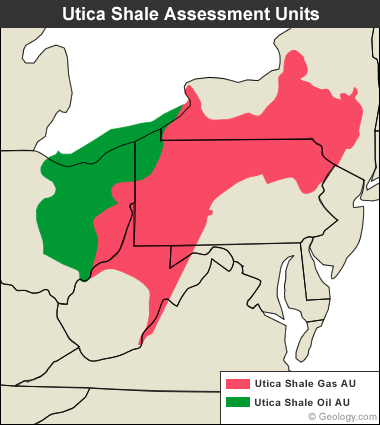
Effigy eleven: Location of the oil and gas assessment units for the Utica Shale determined past the United States Geological Survey. The surface area in green is where wells are likely to run across rough oil. The surface area in pinkish is where natural gas is likely to be the dominant hydrocarbon.
This map was compiled by Geology.com using data from the United States Geological Survey [fifteen].
USGS Oil and Gas Resources Cess
In September 2012, the United States Geological Survey published an "Assessment of Undiscovered Oil and Gas Resources of the Ordovician Utica Shale of the Appalachian Bowl Province, 2012". [fifteen]
They identified two assessment units in the Utica Shale. The geographic areas covered by these units are shown on the map in Figure 11. Their Utica Shale Gas Assessment Unit of measurement (Gas AU) is defined where the thermal maturity of the organic matter is greater than a CAI of 2, and where the total organic carbon is greater than ane weight percentage.
The Utica Shale Oil Assessment Unit (Oil AU) is defined where the thermal maturity of the organic matter is greater than CAI of one but less than a CAI of two, and where the total organic carbon is greater than 1 weight percent.
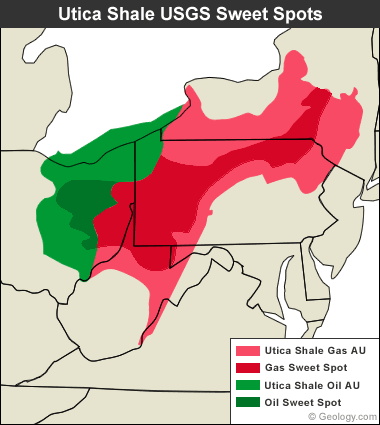
Figure 12: Utica Shale USGS "sweet spots." This map shows the expected optimal areas for developing the Utica Shale according to the USGS assessment of 2012. By and large, these areas are where the Total Organic Carbon (TOC) content of the Utica Shale is high. (See Figure vii for TOC map.)
This map was compiled past Geology.com using data from the U.s.a. Geological Survey [15].
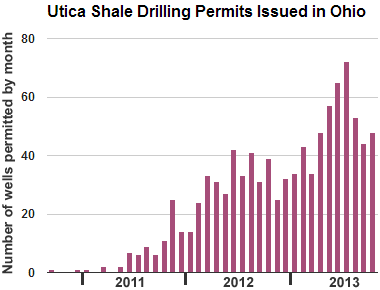
Figure 7: Utica Shale drilling permits issued in Ohio between September 2010 and October 2013. Chart prepared by Geology.com using data from the Ohio Section of Natural Resources.
Utica Shale in Eastern Ohio
Most of the drilling activity in the Utica Shale has occurred in eastern Ohio. This geographic area attracted interest for a variety of reasons which include: 1) the Utica Shale is only a few yard to several thousand feet below the surface; and, 2) wells drilled into the Utica Shale were yielding meaning amounts of natural gas liquids and crude oil. Since 2010 oil and natural gas companies have spent billions of dollars acquiring Utica Shale acreage in eastern Ohio and drilling wells.
The generalized cross sections for the Utica and Marcellus Shale shown to a higher place equally Figures 5a and 5b illustrate why the Utica is existence developed in some parts of Ohio and Canada instead of the Marcellus.
Where cantankerous section 5a traverses the Pennsylvania-Ohio state boundary, the Marcellus Shale is above the Utica and is preferentially drilled because information technology is a shallower target. However, the productive portion of the Marcellus Shale does not extend into central Ohio - but the Utica Shale does. In those areas the Utica Shale is less than 1 mile below the surface.
The Utica Shale is proving to exist rich in oil and natural gas liquids. On an energy-equivalent basis, these wells are worth significantly more than wells that produce natural gas alone. The Ohio Department of Natural Resources estimates a recoverable Utica Shale potential between 1.3 and 5.5 billion barrels of oil and between 3.8 and 15.7 trillion cubic feet of natural gas. Companies interested in drilling the Utica Shale have been flooding ODNR with permit applications (see nautical chart).
Press releases from Chesapeake Free energy reported several wells with peak rates of over five million cubic feet of natural gas per day along with hundreds to thousands of barrels of natural gas liquids. Optimism based upon these drilling results prompted Chesapeake to claim that their Utica Shale assets added over $15 billion in value to the visitor.
This is a valuation of at to the lowest degree $12,000 per acre!
Having achieved successful results from recent drilling activities in eastern Ohio, Chesapeake is announcing the discovery of a major new liquids-rich play in the Utica Shale. Based on its proprietary geoscientific, petrophysical and engineering research during the by ii years and the results of six horizontal and nine vertical wells it has drilled, Chesapeake believes that its industry-leading 1.25 meg net leasehold acres in the Utica Shale play could be worth $xv - $twenty billion in increased value to the visitor.[12]
| Utica Shale References |
| [1] Natural Gas Maps: Exploration, Resources, Reserves and Production: United states of america Free energy Information Administration, www.eia.gov. [2] Assessment of Appalachian Basin Oil and Gas Resources: Utica-Lower Paleozoic Total Petroleum System: Robert T. Ryder, United States Geological Survey, Open-File Report 2008-1287. [3] The Geology of Pennsylvania, Charles H. Schultz, editor; Pennsylvania Geological Survey, Special Publication 1, 1999, 888 pages. [4] Source Rock Distribution and Total Organic Carbon Content: From: Patchen, D.One thousand., and others, 2006, A geologic play book for Trenton-Black River Appalachian Basin exploration: Final written report prepared for U.S. Department of Energy, contract no. DE-FC26-03NT41856. [5] Modern Shale Gas Development in the United States: U.S. Section of Energy Function of Fossil Energy, National Energy Technology Laboratory, Apr 2009. [six] Shale: Description of Sedimentary Rocks, Geology.com, 2010. [7] What is Shale Gas? Free energy Data Administration, December 2010. [8] Geologic Unit of measurement: Utica: United States Geological Survey GEOLEX Database. [9] Update on Regional Cess of Gas Potential in the Devonian Marcellus and Ordovician Utica Shales of New York: Richard Nyahay, James Leone, Langhorne Smith, John Martin, and Daniel Jarvie; Reservoir Characterization Group at the New York State Museum; Search and Discovery Commodity #10136; Oct 2007. [10] A Primer for Understanding Canadian Shale Gas: Energy Briefing Notation, National Energy Board of Canada, November 2009, 23 pages. [11] The Marcellus & Utica Shale Plays in Ohio: PowerPoint Presentation past Larry Wickstrom, Chris Perry, Matt Erenpreiss and Ron Riley; Ohio Geological Survey, ooga.org, 2011. [12] Financial and Operational Results for the 2011 Second Quarter: Chesapeake Free energy Corporation, July 2011. [13] Chesapeake, EnerVest deal a new high-h2o mark for the Utica. FuelFix.com, November 3, 2011. [14] Oil and natural gas drilling in Ohio on the rising. U.S. Free energy Information Administration, October 11, 2011. [fifteen] Assessment of Undiscovered Oil and Gas Resources of the Ordovician Utica Shale of the Appalachian Basin Province, 2012: United States Geological Survey, Fact Sheet 2012-3116, September 2012. [16] Landowners and Oil and Gas Leases in Pennsylvania. Pennsylvania Department of Environmental Protection, Fact Sheet 8000-FS-DEP2834, Nov, 2012. [17] Conodont Color Alteration - an Index to Organic Metamorphism: Anita 1000. Epstein, Jack B. Epstein, and Leonard D. Harris; United states of america Geological Survey, Professional Newspaper 995, 1977. |
Utica Shale in Pennsylvania
Most of the shale drilling activeness in Pennsylvania has targeted the Marcellus Shale, which is above the Utica Shale. In some parts of Pennsylvania the Marcellus Shale is immediately above the Onondaga Limestone. The Utica Shale is located below the Onondaga. Why is that significant? Here is a quote from the Pennsylvania Section of Environmental Protection website that explains:
"Your oil or gas could be produced or captured from a well outside your holding tract boundaries. In fact, your only protection is if your oil or gas property is discipline to the Oil and Gas Conservation Law, 58 P.South. § 401.1 et seq. If so, the gas on your property could be included in a unitization or pooling social club issued past the Democracy at the behest of a producer on a neighboring tract. That well operator would then take to pay y'all a product royalty based on your prorated share of the production from the well, depending on how much of your tract was deemed to be contributing to the well'southward pool. This law applies to oil or gas wells that penetrate the Onondaga horizon and are more than three,800 feet deep."
Video Interview: Potential of Other Gas Shale Formations in the Northeastern United States. Pennsylvania Country University geologist Dr. Terry Engelder describes historical and contempo drilling results for the Utica Shale.
Futurity Evolution of the Utica Shale
Two of import challenges for developing the Utica Shale in Pennsylvania are its significant depth and a lack of information. In areas where the Marcellus Shale is present, the Utica Shale is probably going to be a resources of the distant future. The Marcellus Shale is less expensive to develop, and companies will focus on it before setting their sights on a deeper target with an uncertain payoff.
Withal, in areas where the Marcellus Shale has been adult, the Utica will take an infrastructure advantage. Drilling pads, roadways, pipelines, gathering systems, surveying piece of work, permit preparation data and landowner relationships might still be useful for developing the Utica Shale.
The Utica Shale underlies parts of Lake Erie and Lake Ontario. These areas likely contain natural gas. It is possible that offshore drilling will occur in the lakes in the very distant futurity.
Hydraulic fracturing: Video by Questerre Energy that explains how hydraulic fracturing and horizontal drilling will be used to develop the Utica Shale in Quebec, Canada.
Find Other Topics on Geology.com:
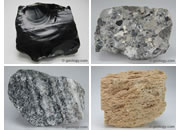 Rocks: Galleries of igneous, sedimentary and metamorphic rock photos with descriptions. | 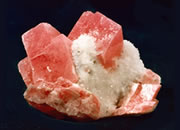 Minerals: Information about ore minerals, gem materials and rock-forming minerals. |
 Volcanoes: Articles about volcanoes, volcanic hazards and eruptions past and present. |  Gemstones: Colorful images and articles about diamonds and colored stones. |
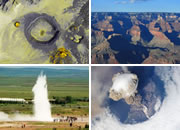 General Geology: Articles about geysers, maars, deltas, rifts, salt domes, water, and much more! |  Geology Store: Hammers, field bags, paw lenses, maps, books, hardness picks, gold pans. |
 | 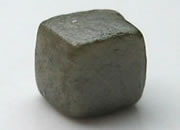 Diamonds: Learn virtually the properties of diamond, its many uses, and diamond discoveries. |
Source: https://geology.com/articles/utica-shale/
0 Response to "Is Rt 12 in Utica Flooded Again"
Post a Comment